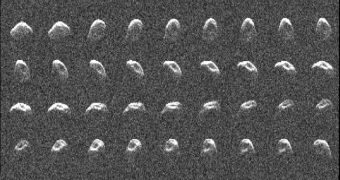Between December 11 and 12, astronomers got the chance to boost their knowledge about near-Earth objects (NEO), and asteroids in general, when they managed to snap a series of images of a space object as it was rotating around itself while traveling through the inner solar system.
The observations were conducted with the NASA Goldstone Solar System Radar, which is located in the Mojave Desert, California. The large radar dish is part of the American space agency's Deep Space Network (DSN), the same instrument used to communicate with missions around other planets.
Astronomers managed to study the NEO called 2010 JL33 in extensive detail. The asteroid was only recently discovered, and so this was a great opportunity for scientists to gain more insight into its basic characteristics, Universe Today reports.
The telescope was able to tease out some of the object's physical properties in a sequence of 36 high-resolution images, which covered about 90 percent of a turn. Previous observations had revealed that the space rock was spinning around its own axis.
In mid-December, it reached its point of closest approach to Earth, and this is why experts decided to conduct their investigations at that time. The data collected was stitched together in a short video clip, showing the asteroid's rotation.
The video was created by experts at the NASA Jet Propulsion Laboratory (JPL), in Pasadena, California. The lab, which is based at the California Institute of Technology (Caltech), manages a large number of the space agency's space missions.
These include the Dawn mission on its way to Ceres and Vesta, the New Horizons spacecraft currently heading towards Pluto, the Mars Exploration Rovers Spirit and Opportunity, the Mars Reconnaissance Orbit and Mars Odyssey and many others.
“Asteroid 2010 JL33 approached within 17 Earth-Moon distances [some 7 million km] in December 2010 and offered an outstanding opportunity to study it with radar. To get detailed radar images, an asteroid must be close to Earth,” says JPL asteroid expert Lance Benner.
The object apparently has a diameter of about 1.8 kilometers (1.1 miles), and completes a rotation around itself once every 9 hours or so. 2010 JL33 was discovered on May 6, 2010.
“The radar images we got enabled us to estimate the asteroid’s size, rotation period, and to see features on its surface, most notably, the large concavity that appears as a dark region in the collage,” Benner adds.
“It was discovered so recently that little else is known about it. This asteroid was also studied by NASA’s Wide-field Infrared Survey Explorer (WISE) spacecraft,” he says.
“Our observations will help WISE scientists calibrate their results because we provided an independent means to estimate the size of this object,” he concludes.

 14 DAY TRIAL //
14 DAY TRIAL //